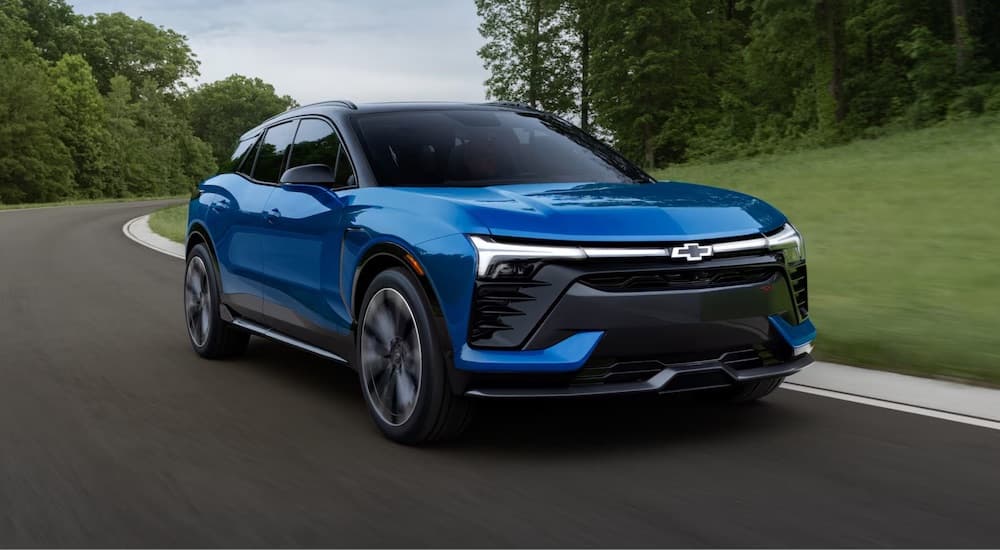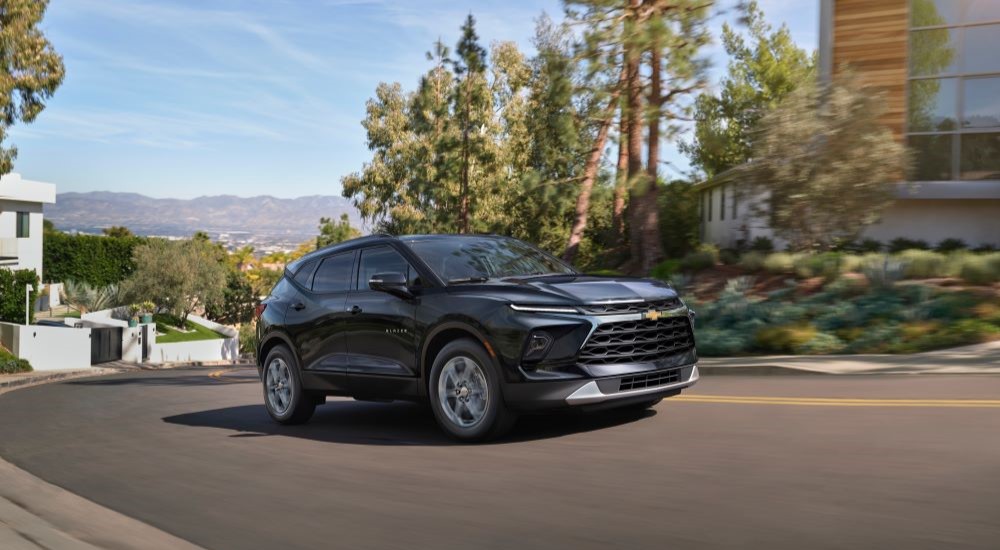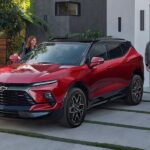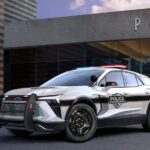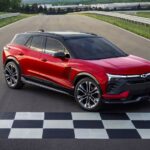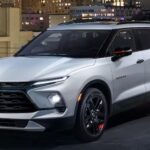The auto industry is trying desperately to move away from internal combustion engines (known colloquially as ICE models) and toward electric vehicles (EVs). Part of Chevy’s 2024 lineup has consisted of a slate of new EV models, one of which is the 2024 Chevy Blazer—but some eagle-eyed enthusiasts may have noticed that the Blazer is not being replaced with an alternative fuel version but instead is being paired with one.
That’s right: the 2024 Blazer is still available as an ICE model, and that’s for several reasons—some may surprise you, while others may have you nodding along. Of course, when it comes to the consumer market, nothing is black and white, and there are a lot of caveats to consider…
Modern and Tech-Rich Features
Drivers looking for a sleek, performance-driven, tech-rich midsize SUV have a lot to enjoy with the 2024 Blazer, thanks to its plentiful standard features, such as LED lighting arrays, a robust infotainment suite, and driver assistance features like lane centering assist and lane departure warnings. When it comes to being competitive among its contemporaries, the gas-powered Blazer doesn’t slouch nor come up short in any way.
The 2024 Blazer offers a lot of what you would want from a fully-featured midsize SUV, from adaptive cruise control and collision mitigation systems to alerts and warnings to maintain your presence on the road. As far as features are concerned, the 2024 Blazer keeps pace with the best of them. It also serves an important role in Chevy’s lineup as the brand’s primary midsize SUV, and this is extremely important because Chevy SUVs rank high in consumer engagement, which leads to another reason why the 2024 Blazer is so important in Chevy’s lineup…
Still Popular in the USA
Having a wide variety of different SUVs available is extremely important. One of the top-selling SUVs on the market right now is Chevy’s compact Equinox. Toyota’s RAV4 tops the charts as the best-selling SUV in the US, but if you look at the charts showing top-selling SUVs broken down by state, the northeast shows a small quadrant dominated by Chevy’s Equinox, as outlined in Edmunds’ top-selling SUV chart of 2022.
Obviously, the Chevy Blazer isn’t the Equinox, but it’s a big deal that Chevy dominates Michigan, Ohio, Indiana, Wisconsin, and Iowa; this means there is brand dominance within those regions for people buying SUVs—specifically from Chevy—and SUVs are the biggest sellers collectively across the US, even though the F-150, Silverado, and Ram 1500 are some of the biggest individual sellers across North America. According to an iSeeCars report, the average market share of SUVs per every ten states is 39.21%, with cars, trucks, and minivans occupying the rest of the market share.
There are only four states where cars are the more dominant vehicle in market share: Arizona, Hawaii, California, and Nevada. This includes EVs, which is an important factor we’ll get to in just a moment. The biggest takeaway from the data on market saturation by vehicle sales per state is that SUVs are super popular and that Chevy’s SUVs have a built-in audience with top-selling marks across a handful of states. This is important for the 2024 Chevy Blazer’s ICE model because of where it ranks in the grand scheme of the SUV market.
A Best-Selling Midsize Model
Even while the Equinox may be Chevy’s top-selling SUV, the Blazer is still one of the best-selling midsize SUVs on the market overall. It ranked as the 16th best-selling midsize SUV of 2022, just ahead of the Subaru Ascent, Nissan Pathfinder, and Dodge Durango. Keep in mind this is still the ICE version of the Chevy Blazer, so this means that it maintains strong appeal as a midsize SUV even in the extremely overcrowded and highly popular midsize division.
To be fair, the Blazer doesn’t always top the “best of” lists from leading reviewers, but that doesn’t mean it hasn’t found a place among actual SUV shoppers in a division that sees stiff competition from the likes of the Ford Bronco, Jeep Wrangler, Ford Explorer, Toyota 4Runner, and Jeep Grand Cherokee; these are huge names regardless of the SUV segment, and they command a strong market presence.
Nevertheless, the Chevy Blazer manages to hold its own; it even reaped better numbers in 2022 than the smaller Chevy Trailblazer, so there is still demand for a sporty-looking and well-regarded midsize SUV from Chevy—especially one that still utilizes combustion chambers to propel itself. And this is a significant point because of the burgeoning EV market.
EV Adoption in Key Territories
In 2019, the total average market share of EVs—including plug-in hybrids and battery-led vehicles—was only 2.11%, according to the EV Adoption market study. Those aren’t promising numbers, but there was a lot to account for in 2019 and the two years that followed, with the pandemic causing serious disruption in the buying, selling, and manufacturing of vehicles. Even still, in 2019, the adoption rate in some of Chevy’s key SUV territories was not good, with places like Michigan seeing only a 0.14% adoption rate, Iowa saw a 0.45% adoption rate, and Wisconsin was at 0.57%. The most promising Chevy SUV market adopter for EVs at the time was Indiana, showing a 0.75% adoption rate.
Since then, the numbers have fluctuated. While some states—like California, Florida, and Texas—have shown growing percentages of registered EVs (according to the US Department of Energy), other states have shown a decline. Some of the most notable declines come from some of the most popular states prone to buying Chevy SUVs—namely, Michigan, Ohio, Indiana, Wisconsin, and Iowa.
According to JD Power, there has actually been a steep decline in adoption rates of EVs in key places across the US throughout 2023, with Montana being the biggest offender with a 4.1% year-over-year decline compared to 2022; this is followed by Hawaii with a 3.9% decline, and New Mexico with a 3.4% drop. Within the top list of declining adoption rates across the US were all of Chevy’s key SUV territories, with Michigan at a 2.8% drop, Ohio at a 2.0% drop, Wisconsin at a 1.1% drop, Indiana at a 1.0% drop, and Iowa at an 0.8% drop.
ICE Is Crucial While EVs Remain on the Threshold
While the 2024 Chevy Blazer EV is being promoted as part of GM’s all-electric future, the future of EVs remains unclear. GM plans to produce up to one million EVs annually by 2025, but they’re still dealing with production woes and battery supply chain bottlenecks; this creates uncertainty for both supply output and potential consumer demand.
The gas-powered 2024 Chevy Blazer is a good barometer to gauge the “between times” of the Blazer EV’s release and the market’s perception of the availability of ICE vs EV models. It’s smart that Chevy didn’t skip a model year for the Blazer’s ICE rendition in preparation for launching the Blazer EV. The 2024 Chevy Blazer still received a couple of updates for the model year in the form of a new exterior color and standard features being added across the trim line.
This is a good boost in confidence to let midsize SUV shoppers know that the 2024 Blazer ICE models aren’t being completely tossed to the wayside but that there is at least going to be some symmetry between the availability of the classic ICE model and the new EV model being on the market at the same time. Could this create cannibalization? Highly unlikely.
In Chevy’s key SUV territories, the Blazer ICE models will likely do as well as they’ve usually done. Anyone interested in a modern midsize SUV that offers the most up-to-date features across the tech and safety front can still get it with the 2024 Blazer, with built-in features like Buckle-to-Drive and Teen Driver being standard across the trim line. You also still have a 10.2-inch HD touchscreen, app support, wireless smart device integration, and OnStar—features that have helped define Chevy’s modern-day lineup. It’s not as if you’re left wanting for tech from the ICE rendition of the Blazer compared to the EV version.
The Blazer EV would be the real wildcard, given that it would have to sell well outside of Chevy’s territorial SUV domains—domains that have not shown a lot of inclinations toward EV adoption—so there will be some challenges and growing pains for Chevy to overcome in that regard. Compared to the EV model, the gas-powered 2024 Chevy Blazer is a seemingly safe bet for both Chevy and SUV shoppers.
Relying on ICE-Powered SUVs for the Near Future
GM has made it known that they want to move into an all-electric future. They are obviously putting a lot of resources and time into turning this venture into a reality. However, the core consumer base for many of their products is still glued to traditional combustion-based vehicles, and prying them away will be difficult. It appears as if there is a strong awareness of consumer attachment to Chevy’s ICE models, and it’s why they aren’t being phased out completely in an attempt to simply force-feed the market with alt-fuel vehicles.
The 2024 Chevy Blazer ICE model shows a continued commitment to gas-powered SUV shoppers looking to maintain the status quo. A slight update to the model year also shows that Chevy wasn’t willing to entirely forego the model in an attempt to rely on the Blazer EV alone in the midsize SUV segment. If the 2024 Blazer is any indication, there is still a strong sense of confidence in the gas-powered segment from SUV shoppers looking for a sleek and feature-rich vehicle that gets you to and from your destination the old-fashioned way.
How long will it be that way? Who can say for sure? For now, we at least know that the near future is still going to rely on good old-fashioned combustion chambers for quite a few Chevy drivers.
